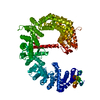+Search query
-Structure paper
| Title | Structural basis for cooperativity of CRM1 export complex formation. |
|---|---|
| Journal, issue, pages | Proc Natl Acad Sci U S A, Vol. 110, Issue 3, Page 960-965, Year 2013 |
| Publish date | Jan 15, 2013 |
 Authors Authors | Thomas Monecke / David Haselbach / Béla Voß / Andreas Russek / Piotr Neumann / Emma Thomson / Ed Hurt / Ulrich Zachariae / Holger Stark / Helmut Grubmüller / Achim Dickmanns / Ralf Ficner /  |
| PubMed Abstract | In eukaryotes, the nucleocytoplasmic transport of macromolecules is mainly mediated by soluble nuclear transport receptors of the karyopherin-β superfamily termed importins and exportins. The highly ...In eukaryotes, the nucleocytoplasmic transport of macromolecules is mainly mediated by soluble nuclear transport receptors of the karyopherin-β superfamily termed importins and exportins. The highly versatile exportin chromosome region maintenance 1 (CRM1) is essential for nuclear depletion of numerous structurally and functionally unrelated protein and ribonucleoprotein cargoes. CRM1 has been shown to adopt a toroidal structure in several functional transport complexes and was thought to maintain this conformation throughout the entire nucleocytoplasmic transport cycle. We solved crystal structures of free CRM1 from the thermophilic eukaryote Chaetomium thermophilum. Surprisingly, unbound CRM1 exhibits an overall extended and pitched superhelical conformation. The two regulatory regions, namely the acidic loop and the C-terminal α-helix, are dramatically repositioned in free CRM1 in comparison with the ternary CRM1-Ran-Snurportin1 export complex. Single-particle EM analysis demonstrates that, in a noncrystalline environment, free CRM1 exists in equilibrium between extended, superhelical and compact, ring-like conformations. Molecular dynamics simulations show that the C-terminal helix plays an important role in regulating the transition from an extended to a compact conformation and reveal how the binding site for nuclear export signals of cargoes is modulated by different CRM1 conformations. Combining these results, we propose a model for the cooperativity of CRM1 export complex assembly involving the long-range allosteric communication between the distant binding sites of GTP-bound Ran and cargo. |
 External links External links |  Proc Natl Acad Sci U S A / Proc Natl Acad Sci U S A /  PubMed:23277578 / PubMed:23277578 /  PubMed Central PubMed Central |
| Methods | EM (single particle) / X-ray diffraction |
| Resolution | 2.941 - 18.0 Å |
| Structure data |  EMDB-2110:  EMDB-2111:  PDB-4fgv:  PDB-4hzk: |
| Source |
|
 Keywords Keywords |  TRANSPORT PROTEIN / TRANSPORT PROTEIN /  HEAT repeat protein / Importin-beta superfamily / Nuclear export of numerous protein and RNP cargoes / Nuclear export receptor HEAT repeat protein / Importin-beta superfamily / Nuclear export of numerous protein and RNP cargoes / Nuclear export receptor |
 Movie
Movie Controller
Controller Structure viewers
Structure viewers About Yorodumi Papers
About Yorodumi Papers




